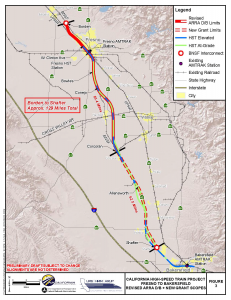In a favorite novel, an Iowa farmer named Ray Kinsella hears a disembodied voice speaking to him from a cornfield. "If you build it, he will come," the voice says. And thus begins a cross-country fantasy that's equal parts baseball and personal redemption.
That's fiction. Anything goes. But it's a little surprising to find that the California High-Speed Rail Authority seems to be adopting the "if you build it" approach to choosing the first segment of the state's bullet-train route.

Or maybe not so surprising, if you step back. Money talks, and the authority is hearing voices, too—specifically, the commanding tones of the Federal Railroad Administration. Earlier this fall, FRA not only gave California the good news that it was awarding $715 million to help get high-speed rail rolling, but also that the money would need to be spent in the San Joaquin Valley. (Why there? Despite the wealth of published material, from the agency itself and from some decent reporters, we don't see explicit reasoning beyond the following speculation: there's less political opposition to high-speed rail in the Valley than in the Bay Area; it would be cheaper and less complicated to build the initial segment in the Valley than in the heavily populated Los Angeles-San Diego corridor; and, with the Valley's economy in a prolonged deep slump because of the collapse of housing construction, it needs a big economic shot in the arm.)
The federal rail people have left it to California, though, to decide exactly where in the San Joaquin Valley the first segment should be built. The two choices were a piece from Merced to Fresno, about 60 miles, or one from Fresno to Bakersfield, 110 miles or so. Earlier this week, the High-Speed Rail Authority staff announced a choice: a hybrid segment from Borden, a hamlet on the outskirts of Madera, 20 miles north of Fresno, to Corcoran, 45 miles south of Fresno. The authority's board, which faces an end-of-the-year deadline to get its hands on the new federal grant, will consider the recommendation at its board meeting next Thursday, Dec. 2.
If Rep. Dennis Cardoza's reaction to the segment proposal is anything to go by, the rail board is going to hear from some angry people. Cardoza, a Democrat whose 18th Congressional District includes Merced—a town left out of the rail authority's proposal—issued a press release accusing the authority of a "bait and switch" and demanding an investigation into its route-selection process. (Cardoza's not the only one who's upset. See the California High Speed Rail Blog: "Merced HSR Supporters Angry at Construction Proposal.")